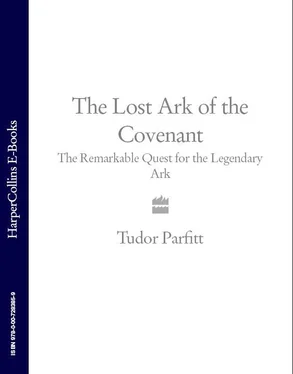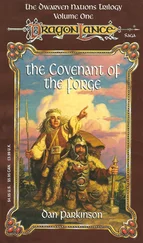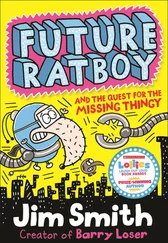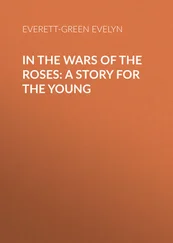Suddenly, the path fell away under my feet and it was only Tagaruze’s swiftness in grabbing my arm that prevented me from disappearing over the edge. Loose stones fell over the cliff in a tidy avalanche. A flat, neat echo sounded below us. We paused and looked down into the ravine. I could just make out the outline of the final stage of the descent which led down the cliff opposite the great wall of rock.
Carefully we edged our way down. Once there was a crack of branches; once the sound of a large bird and of rushing air, then silence. I wondered if this was the ‘bird of heaven’, the creature Sevias had claimed was one of the protectors of Dumghe.
We reached the base of the two great rocks. There was another sound of a branch snapping. Perhaps the Lemba did keep someone posted here all the time to guard their treasures, after all. There was only space for us to walk one abreast. I led the way, flashing my torch around until we reached what appeared to be the entrance to the cave. This, I thought, must be the Lemba holy of holies. Between the boulder and the cliff face there was a mound of loose scree. I placed my desert-booted foot on it, holding the torch with one hand and resting the other against the side of a boulder. There was nothing to be seen. Encouraged, I went through the narrow entrance and pointed my torch straight ahead. All I could see was a wall of rock.
But I could hear something: a sort of rasping sound, a cough or a snarl, and then a louder sound - a snort, perhaps, which became a deafening roar as it bounced off the surrounding rockface. My hand gripped the torch in terror. My legs turned to jelly. The gun, I thought, shoot it whatever it is. Tagaruze had the gun but when I turned around I realized that Tagaruze was no longer behind me. Tagaruze had disappeared. I was alone.
I retreated through the opening, back first, keeping my face to the sound and then scrambled up the narrow track after him and fled through the wooded slopes of Dumghe. The noise followed us, rising through the natural shaft made by the great rocks high into the mountain. It was a terrifying sound - it could have been a lion or a leopard or just about anything else. We did not wait to find out. We ran as fast as we could until we got to the meshunah tree.
Breathlessly we sat down at the base of the tree. As my rump hit the ground I felt something slithering away under me into the undergrowth. Shuddering, I stood up quickly.
‘What the hell was that?’ I asked.
‘That was just a snake,’ Tazaruze said offhandedly.
My blood turned cold and I felt like throwing up. I had been told that one of the guardians of the ngoma was a two-headed snake. I was a million times more afraid of even the smallest, most inoffensive grass snake than of any cat, great or small, on the face of the earth.
I shuddered. ‘And how about that thing in the cave?’ ‘It must have been a Lemba ancestor in the body of a leopard or a lion. Or it was the protectors of the ngoma , the lions of the Almighty, the guardians of the king. Everyone knows they prowl around this mountain. This was a terrible, big mistake.’
What the policeman had said was undoubtedly true. It was a mistake. I was to rue that mistake for many years to come. We did not find the elusive and mysterious ngoma lungundu, the strange artefact which played such an important role in the imagination of this remote African tribe, but the events of that night were to change my life and lead me on a quest which would only be resolved many, many years later.
S’ orry. It’s a forgery!’ It was my very first meeting with Reuven. The year was 1992, half a decade after my adventure at the mouth of the cave at Dumghe. We were in my vaulted study in the Old City of Jerusalem. A weird light seemed to be coming from a yellowing document, which was spread out on the table.
Reuven ben Arieh was a financier and diamond merchant, a highly orthodox Jew and a highly unorthodox everything else. He lived mainly in Jerusalem but also had homes in Paris, London, and Miami. He was a tall, full-bearded, well-built man. The first thing I noticed about him was his eyes. Those eyes were something. This man was something. He had a beautiful, soft-spoken wife, Clara, admired by everyone, and a lifeabsorbing mission.
His mission was stark in its simplicity and bound to fail: it was to end gentile hatred of Jews. To terminate anti-Semitism. For once and for all. It was as simple as that.
Hatred of Jews was a subject about which he had some personal experience: most members of his immediate family, including his father and mother, brother, and sister had been murdered at Treblinka. Reuven, who was about ten years older than me, was born in Holland in 1935. During the Nazi occupation, he spent three years hidden in a neighbour’s garret. In 1945 he emerged to discover that he was an orphan. Later that year he was claimed by some elderly and wealthy childless relatives of his mother’s who brought him up. They died in the early 1950s, leaving him their fortune. He studied chemistry in France, took up his father’s trade of diamond cutter for a few years, and then in 1953 moved to Israel.
By the time I met him he had fought in three wars against Arab states: the Sinai Campaign of 1956, the 1967 Six-Day War, and the Yo m Kippur War of 1973.
It was the hostility of Muslims and Arabs towards Israel and Jews that was of most concern to him. It was this hostility, particularly, that he wanted to eliminate from the world. Whenever I subsequently met him - and wherever I met him - it was Arab and Muslim resentment of Israel and how to combat it that he really wanted to talk about.
A few days previously Reuven had purchased the manuscript from Anis, one of the Jerusalem dealers. It could be dated more or less to the time of the Prophet Muhammad. So he said. It was going to change the world.
When he arrived at my house in the Old City that late summer’s day, clutching his tattered manuscript, Reuven was as excited as I have ever seen him, before or since.
He was wearing a very stylish version of the black hat, long dark jacket, and trousers worn by observant European Jews.
But everything was subtly wrong. Despite the heat and dust, his clothes were spotless, and immaculately cut by a Parisian tailor. The tropical weight woollen cloth of his suit was a very dark blue worsted with a herringbone pattern. He gave off a slight suggestion of Chanel Homme . As I was to discover later, he usually had his hair cut in New York, went for regular manicures, and his hand-made shirts came from Turnbull & Asser in London’s Jermyn Street. Although I am not Jewish, I had lived in Israel for many years and was familiar with many aspects of the Jewish religion and culture, and it was clear to me that Reuben looked like no other orthodox Jew in Jerusalem - and I told him so.
Grinning at me he said, ‘I want people to say - Hey! Reuven that handsome guy! That beautifully dressed orthodox Jew!’
He had ‘returned’ to Judaism just after the Yo m Kippur War. Before that, he had been a completely secular Israeli. He was now what is known as a baal teshuvah - a sort of born-again Jew. He maintained a fastidiously kosher home but elsewhere he would occasionally eat in a non-kosher restaurant. Since his conversion to Orthodox Judaism, he had immersed himself in the Talmud - the great Jewish collection of religious law - and the Jewish mysticism of the kabbala.
However, he also had what he referred to as his ‘principal interest’. For many years he had been scouring Islamic texts trying to find something that could be exploited to neutralize - or better, eradicate - Muslim hatred of Israel and Jews. What he was looking for was some ancient, unknown Islamic text praising the Jews or foretelling the return of the Jews to Palestine, something that would make the settlement of Muslim land by Jews seem ordained by Allah, something that would legitimize Zionism in the eyes of the Arab world, something that would destroy Muslim hatred of Israel. It was an extraordinary idea.
Читать дальше












